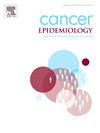Comorbidity burden and risk of second primary non-breast cancer in breast cancer survivors
IF 2.3
3区 医学
Q3 ONCOLOGY
引用次数: 0
Abstract
Background
Breast cancer survivors have an increased risk of second primary cancers. However, the impact of comorbidity burden on risk of second primary non-breast cancer in breast cancer survivors is under-studied. We evaluated the association of comorbidity burden with risk of second primary non-breast cancer in breast cancer survivors.
Methods
In this retrospective cohort study, breast cancer patients aged ≥ 18 years diagnosed with in-situ, local, or regional first primary breast between 2008 and 2020 at Kaiser Permanente Southern California, were included. Patients were followed until 12/31/2021. Rates of second primary non-breast cancer were reported. Association of Elixhauser comorbidity index (ECI) and second primary cancer was reported using Cox proportional hazards regression.
Results
Of 37,222 female breast cancer survivors included, 1701 (4.6 %) survivors developed second primary non-breast cancers during a median (interquartile range) follow-up of 5.2 (2.8–8.6) years. Nearly one-third (32.3 %) of the survivors had ECI score 3 + ; 22.6 % had ECI score 1–2; rest 27.0 % had zero ECI score. Incidence rates of second cancers were 561, 739, and 1064 per 100,000 person-years in survivors with ECI= 0, 1–2, and 3 + , respectively. In multivariable analyses, compared to survivors with ECI= 0, survivors with ECI scores 1–2 and 3 + had higher risk of second primary non-breast cancer [unadjusted HR (95 % CI): 1.32 (1.16–1.50) and 1.88 (1.65–2.14), respectively]. Higher risk of second primary non-breast cancer persisted in survivors with ECI score 3 + in the adjusted model [adjusted HR (95 % CI): 1.24 (1.08–1.43)].
Conclusion
Comorbidity burden appears to be correlated with an increased risk of second primary non-breast cancers in breast cancer survivors. Active surveillance and effective management of modifiable comorbidities may help in reducing second primary cancer risk in breast cancer survivors.
乳腺癌幸存者第二原发性非乳腺癌的合并症负担和风险
背景:乳腺癌幸存者患第二原发癌症的风险增加。然而,合并症负担对乳腺癌幸存者第二原发性非乳腺癌风险的影响尚未得到充分研究。我们评估了乳腺癌幸存者的合并症负担与第二原发性非乳腺癌风险的关系。方法在这项回顾性队列研究中,纳入了2008年至2020年在Kaiser Permanente Southern California诊断为原位、局部或区域性原发性乳腺癌的年龄≥ 18岁的乳腺癌患者。随访至2021年12月31日。报告了第二原发性非乳腺癌的发生率。采用Cox比例风险回归法报道Elixhauser合并症指数(ECI)与第二原发癌的相关性。结果在纳入的37222名女性乳腺癌幸存者中,1701名(4.6 %)幸存者在5.2(2.8-8.6)年的中位(四分位数范围)随访期间发生了第二原发性非乳腺癌。近三分之一(32.3% %)的幸存者ECI评分为3 + ;ECI评分1-2的患者占22.6% ;其余27.0 % ECI评分为0。在ECI= 0、1-2和3 + 的幸存者中,第二种癌症的发病率分别为561,739和1064 / 100000人年。在多变量分析中,与ECI= 0的幸存者相比,ECI评分为1-2和3 + 的幸存者患第二原发性非乳腺癌的风险更高[未经调整的HR(95 % CI)分别为1.32(1.16-1.50)和1.88(1.65-2.14)]。在调整后的模型中,ECI评分为3 + 的幸存者存在较高的第二原发性非乳腺癌风险[调整后的HR(95 % CI): 1.24(1.08-1.43)]。结论乳腺癌幸存者的合并症负担与第二原发非乳腺癌风险增加相关。积极监测和有效管理可改变的合并症可能有助于降低乳腺癌幸存者的第二原发癌风险。
本文章由计算机程序翻译,如有差异,请以英文原文为准。
求助全文
约1分钟内获得全文
求助全文
来源期刊

Cancer Epidemiology
医学-肿瘤学
CiteScore
4.50
自引率
3.80%
发文量
200
审稿时长
39 days
期刊介绍:
Cancer Epidemiology is dedicated to increasing understanding about cancer causes, prevention and control. The scope of the journal embraces all aspects of cancer epidemiology including:
• Descriptive epidemiology
• Studies of risk factors for disease initiation, development and prognosis
• Screening and early detection
• Prevention and control
• Methodological issues
The journal publishes original research articles (full length and short reports), systematic reviews and meta-analyses, editorials, commentaries and letters to the editor commenting on previously published research.
 求助内容:
求助内容: 应助结果提醒方式:
应助结果提醒方式:


